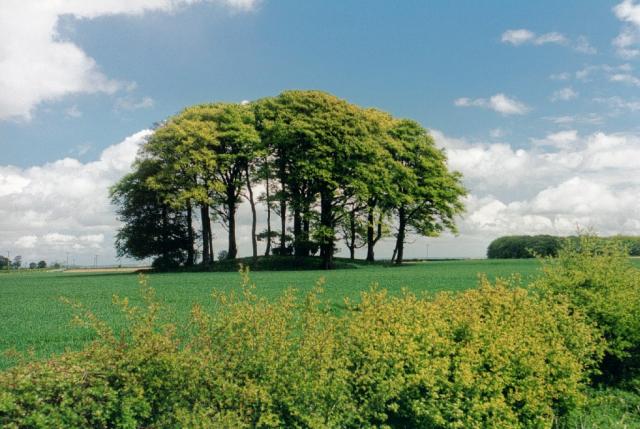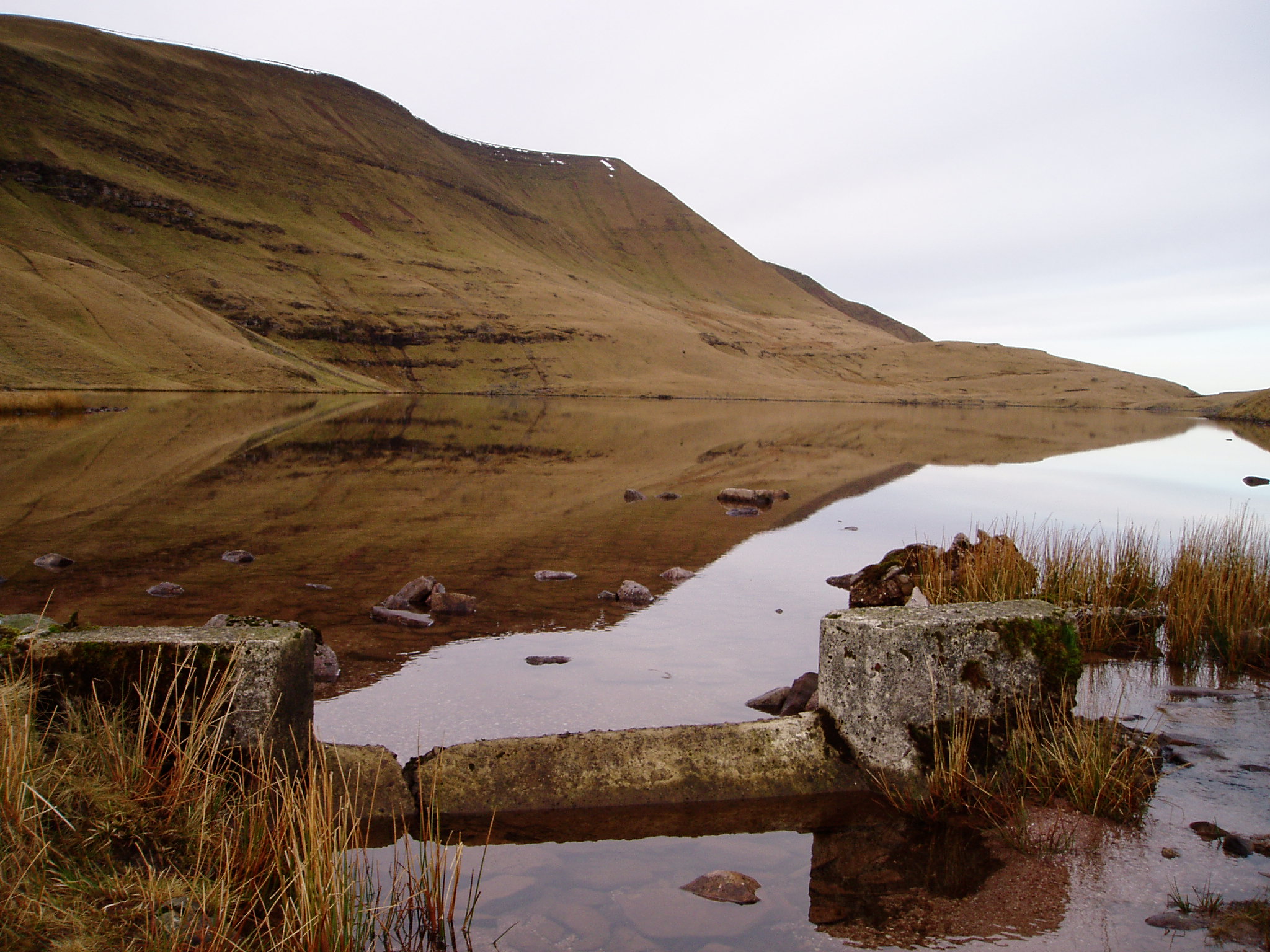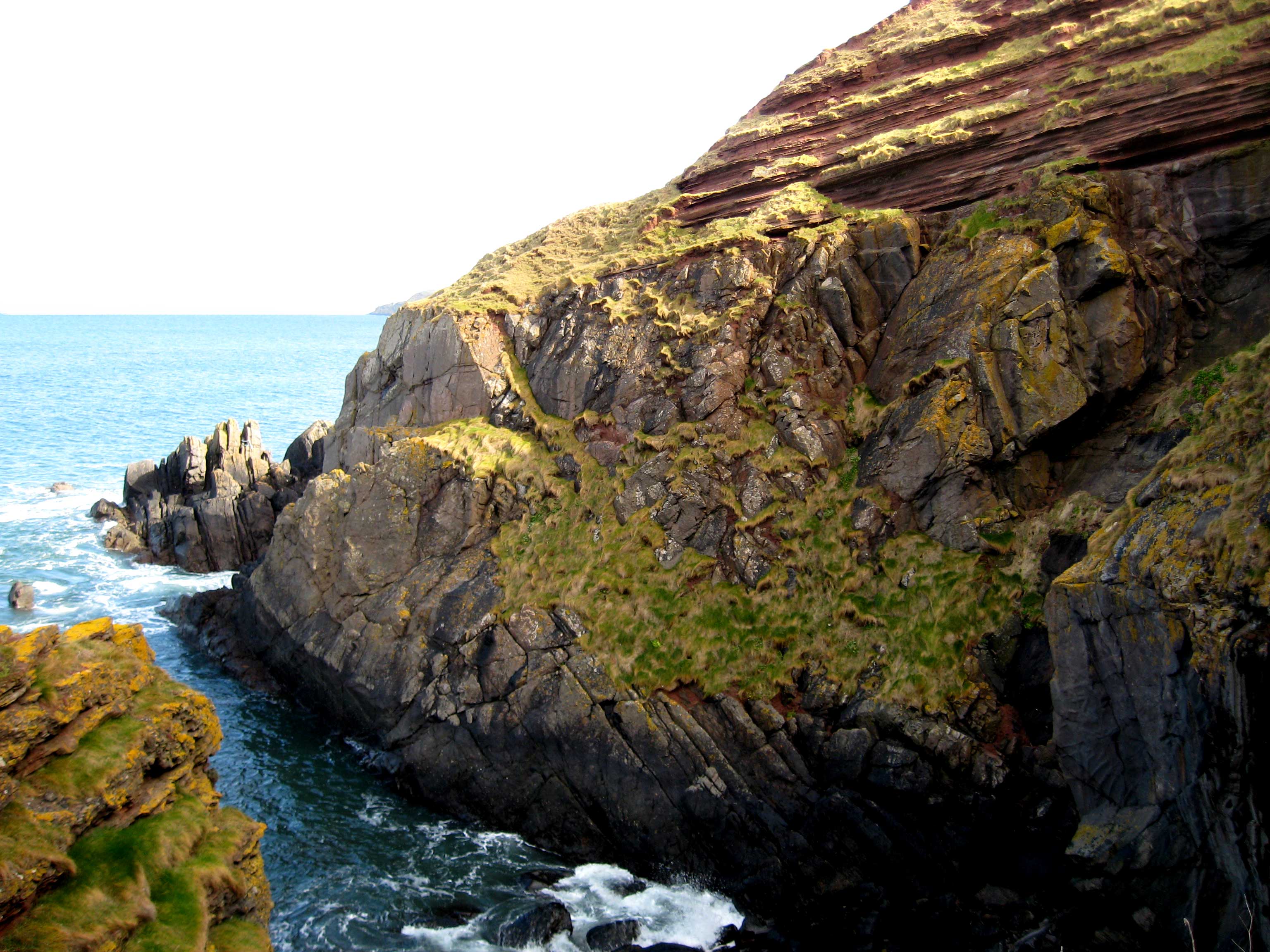|
Trichrug
Trichrug (also referred to as Pen-y-bicws) is a hill four miles east of Llandeilo and 3 miles south of Llangadog in the county of Carmarthenshire, southwest Wales. It lies within the Brecon Beacons National Park and Fforest Fawr Geopark. Its summit at a height of 415m above sea level is marked by a trig point. It is a Marilyn with a prominence of 191 metres. Geology The hill is formed from a suite of rocks of mid-Silurian age which are tilted steeply towards the southeast forming a part of the Myddfai Steep Belt. The summit and the crest of the ridge extending southwest and northeast is formed from the Trichrug Sandstone. Its northwestern slopes are largely formed in the mudstones and sandstones of the Hafod Fawr Formation whilst its southeastern slopes are largely formed from the Raglan Mudstone Formation. These rocks are the uppermost (i.e. youngest) Silurian rocks of the area but are also considered to be the lowermost (i.e. oldest) beds of the Old Red Sandstone succession. ... [...More Info...] [...Related Items...] OR: [Wikipedia] [Google] [Baidu] |
Marilyn (hill)
This is a list of Marilyn hills and mountains in the United Kingdom, Isle of Man and Ireland by height. Marilyns are defined as peaks with a prominence of or more, regardless of height or any other merit (e.g. topographic isolation, as used in Munros). Thus, Marilyns can be mountains, with a height above , or relatively small hills. there were 2,011 recorded Marilyns. Definition The Marilyn classification was created by Alan Dawson in his 1992 book ''The Relative Hills of Britain''. The name Marilyn was coined by Dawson as a punning contrast to the '' Munro'' classification of Scottish mountains above , but which has no explicit prominence threshold, being homophonous with (Marilyn) '' Monroe''. The list of Marilyns was extended to Ireland by Clem Clements. Marilyn was the first of several subsequent British Isles classifications that rely solely on prominence, including the P600s, the HuMPs, and the TuMPs. Topographic prominence is a more difficult to estimate than ... [...More Info...] [...Related Items...] OR: [Wikipedia] [Google] [Baidu] |
Llangadog
Llangadog () is a village and community located in Carmarthenshire, Wales, which also includes the villages of Bethlehem and Capel Gwynfe. A notable local landscape feature is Y Garn Goch with two Iron Age hill forts.The Welsh Academy Encyclopedia of Wales. Cardiff: University of Wales Press 2008. Llangadog was the administrative centre of the commote of Perfedd and had a castle, destroyed in 1204. Although the borough declined in the Middle Ages, Llangadog retained its market, which was frequented by drovers into the 19th century. The railway station on the Heart of Wales Line provides regular train services via Transport for Wales Rail. The station had a siding for accessing the Co-op Wholesale Society creamery, allowing milk trains to access the site. After railway access was ceased in the late 1970s, the creamery continued to operate until 2005, when it closed with the loss of 200 jobs. The site has since been redeveloped as a pet food factory. St Cadog's Church The Ch ... [...More Info...] [...Related Items...] OR: [Wikipedia] [Google] [Baidu] |
Carmarthenshire
Carmarthenshire ( cy, Sir Gaerfyrddin; or informally ') is a county in the south-west of Wales. The three largest towns are Llanelli, Carmarthen and Ammanford. Carmarthen is the county town and administrative centre. The county is known as the "Garden of Wales" and is also home to the National Botanic Garden of Wales. Carmarthenshire has been inhabited since prehistoric times. The county town was founded by the Romans, and the region was part of the Kingdom of Deheubarth in the High Middle Ages. After invasion by the Normans in the 12th and 13th centuries it was subjugated, along with other parts of Wales, by Edward I of England. There was further unrest in the early 15th century, when the Welsh rebelled under Owain Glyndŵr, and during the English Civil War. Carmarthenshire is mainly an agricultural county, apart from the southeastern part which was once heavily industrialised with coal mining, steel-making and tin-plating. In the north of the county, the woollen in ... [...More Info...] [...Related Items...] OR: [Wikipedia] [Google] [Baidu] |
Wales
Wales ( cy, Cymru ) is a Countries of the United Kingdom, country that is part of the United Kingdom. It is bordered by England to the Wales–England border, east, the Irish Sea to the north and west, the Celtic Sea to the south west and the Bristol Channel to the south. It had a population in 2021 of 3,107,500 and has a total area of . Wales has over of coastline and is largely mountainous with its higher peaks in the north and central areas, including Snowdon (), its highest summit. The country lies within the Temperateness, north temperate zone and has a changeable, maritime climate. The capital and largest city is Cardiff. Welsh national identity emerged among the Celtic Britons after the Roman withdrawal from Britain in the 5th century, and Wales was formed as a Kingdom of Wales, kingdom under Gruffydd ap Llywelyn in 1055. Wales is regarded as one of the Celtic nations. The Conquest of Wales by Edward I, conquest of Wales by Edward I of England was completed by 1283, th ... [...More Info...] [...Related Items...] OR: [Wikipedia] [Google] [Baidu] |
Brecon Beacons National Park
The Brecon Beacons National Park ( cy, Parc Cenedlaethol Bannau Brycheiniog) is one of three national parks in Wales, and is centred on the Brecon Beacons range of hills in southern Wales. It includes the Black Mountain ( cy, Y Mynydd Du) in the west, Fforest Fawr (translates as 'great forest') and the Brecon Beacons in the centre and the Black Mountains ( cy, Y Mynydd Du or Mynyddoedd Duon) in the east. Description The Brecon Beacons National Park was established in 1957, the last of the three Welsh parks designated after Snowdonia in 1951 and the Pembrokeshire Coast in 1952. It stretches from Llandeilo in the west to Hay-on-Wye in the northeast and Pontypool in the southeast, covering and encompassing four main regions – the Black Mountain in the west, reaching 802 metres (2631 feet) at Fan Brycheiniog, Fforest Fawr and the Brecon Beacons in the centre, including the highest summit in the park and in South Wales at Pen y Fan 886 metres (2,907 feet) and the confusingly ... [...More Info...] [...Related Items...] OR: [Wikipedia] [Google] [Baidu] |
Fforest Fawr Geopark
Fforest Fawr Geopark is a Geopark in the Brecon Beacons National Park, south Wales. It is the first designated Geopark in Wales having gained membership of both the European Geoparks Network and the UNESCO-assisted Global Network of National Geoparks in October 2005. The Geopark aims to promote and support sustainable tourism and other opportunities to improve the economy of the area whilst safeguarding the natural environment. Its aims largely coincide with the statutory duties and purpose of the National Park within which it sits. History of designation An initial application to the European Geoparks Network (EGN) made for a more geographically restricted Geopark based on the upper Swansea Valley was turned down in 2003 but the present area which extends to was accepted by the EGN at their meeting in October 2005. A Geopark Development Officer was appointed in January 2007 whilst the National Park Authority also employs an education officer part of whose time is dedicate ... [...More Info...] [...Related Items...] OR: [Wikipedia] [Google] [Baidu] |
Trig Point
A triangulation station, also known as a trigonometrical point, and sometimes informally as a trig, is a fixed surveying station, used in geodetic surveying and other surveying projects in its vicinity. The nomenclature varies regionally: they are generally known as trigonometrical stations or triangulation stations in North America, trig points in the United Kingdom, trig pillars in Ireland, trig stations or trig points in Australia and New Zealand, and trig beacons in South Africa. Use The station is usually set up by a government with known coordinates and elevation published. Many stations are located on hilltops for the purposes of visibility. A graven metal plate on the top of a pillar may provide a mounting point for a theodolite or reflector, often using some form of kinematic coupling to ensure reproducible positioning. Trigonometrical stations are grouped together to form a network of triangulation. Positions of all land boundaries, roads, railways, bridges and ot ... [...More Info...] [...Related Items...] OR: [Wikipedia] [Google] [Baidu] |
Llandeilo
Llandeilo () is a town and community in Carmarthenshire, Wales, situated at the crossing of the River Towy by the A483 on a 19th-century stone bridge. Its population was 1,795 at the 2011 Census. It is adjacent to the westernmost point of the Brecon Beacons National Park. The town is served by Llandeilo railway station on the Heart of Wales Line. In 2021, ''The Sunday Times'' called the town one of the top six places to live in Wales. The newspaper praised the town as a ‘sophisticated shopping destination and a great showcase for local arts and crafts’. Early history Roman soldiers were active in the area around Llandeilo around AD74, as evidenced by the foundations of two castra discovered on the grounds of the Dinefwr estate. The fortifications measured 3.85 hectares and 1.54 hectares, respectively. Roman roads linked Llandeilo with Llandovery and Carmarthen. A small civil settlement developed outside the gates of the fort and may have continued in use as the embryo ... [...More Info...] [...Related Items...] OR: [Wikipedia] [Google] [Baidu] |
Silurian
The Silurian ( ) is a geologic period and system spanning 24.6 million years from the end of the Ordovician Period, at million years ago (Mya), to the beginning of the Devonian Period, Mya. The Silurian is the shortest period of the Paleozoic Era. As with other geologic periods, the rock beds that define the period's start and end are well identified, but the exact dates are uncertain by a few million years. The base of the Silurian is set at a series of major Ordovician–Silurian extinction events when up to 60% of marine genera were wiped out. One important event in this period was the initial establishment of terrestrial life in what is known as the Silurian-Devonian Terrestrial Revolution: vascular plants emerged from more primitive land plants, dikaryan fungi started expanding and diversifying along with glomeromycotan fungi, and three groups of arthropods ( myriapods, arachnids and hexapods) became fully terrestrialized. A significant evolutionary milestone d ... [...More Info...] [...Related Items...] OR: [Wikipedia] [Google] [Baidu] |
Myddfai Steep Belt
The Myddfai Steep Belt is a geological structure which affects rocks of Silurian and Devonian age in mid Wales. It extends for tens of miles across country from near Carmarthen northeastwards via Mynydd Myddfai, Mynydd Bach Trecastell and Mynydd Epynt to the vicinity of Llangammarch Wells. Within this linear zone, the rock beds have been tilted steeply to the southeast. The folding took place in late Silurian to early Devonian times. This structure gives rise to a series of landscape features along its length, not least the steep northwest-facing scarps of the hills and ranges mentioned above. Indeed, the feature can be seen as a significant lineament in aerial and satellite views of Wales. The Steep Belt effectively marks the southeastern edge of the intensely folded region of the Caledonian Orogenic Belt in central Wales. A series of major folds and faults affect the Ordovician and Silurian rocks to its northwest whilst folding and faulting of the Devonian rocks to its southe ... [...More Info...] [...Related Items...] OR: [Wikipedia] [Google] [Baidu] |
Old Red Sandstone
The Old Red Sandstone is an assemblage of rocks in the North Atlantic region largely of Devonian age. It extends in the east across Great Britain, Ireland and Norway, and in the west along the northeastern seaboard of North America. It also extends northwards into Greenland and Svalbard. These areas were a part of the ancient continent of Euramerica/Laurussia. In Britain it is a lithostratigraphic unit (a sequence of rock strata) to which stratigraphers accord supergroup status and which is of considerable importance to early paleontology. For convenience the short version of the term, ORS is often used in literature on the subject. The term was coined to distinguish the sequence from the younger New Red Sandstone which also occurs widely throughout Britain. Sedimentology The Old Red Sandstone describes a suite of sedimentary rocks deposited in a variety of environments during the Devonian but extending back into the late Silurian and on into the earliest part of the ... [...More Info...] [...Related Items...] OR: [Wikipedia] [Google] [Baidu] |








